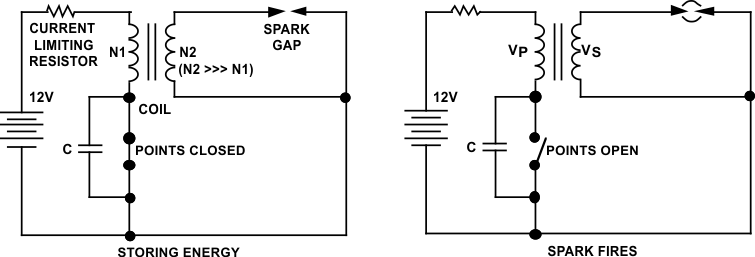SNVA559C September 2012 – February 2019 LM2574 , LM2575-N , LM2575HV , LM2576 , LM2576HV , LM2577
-
Switching regulator fundamentals
- Trademarks
- 1 Switching Fundamentals
- 2 Switching Converter Topologies
- 3 Application Hints for Switching Regulators
- 4 Application Circuits
- 5 References and Related Products
- Revision History
1.2 Transformer Operation
A transformer is a device that has two or more magnetically-coupled windings. The basic operation is shown in Figure 2.
 Figure 2. Transformer Theory
Figure 2. Transformer Theory The action of a transformer is such that a time-varying (AC) voltage or current is transformed to a higher or lower value, as set by the transformer turns ratio. The transformer does not add power, so it follows that the power (V X I) on either side must be constant. That is the reason that the winding with more turns has higher voltage but lower current, while the winding with less turns has lower voltage but higher current.
The dot on a transformer winding identifies its polarity with respect to another winding, and reversing the dot results in inverting the polarity.
Example of Transformer Operation:
An excellent example of how a transformer works can be found under the hood of your car, where a transformer is used to generate the 40 kV that fires your car's spark plugs (see Figure 3).
 Figure 3. Spark Firing Circuit
Figure 3. Spark Firing Circuit The coil used to generate the spark voltage is actually a transformer, with a very high secondary-to-primary turns ratio.
When the points first close, current starts to flow in the primary winding and eventually reaches the final value set by the 12-V battery and the current-limiting resistor. At this time, the current flow is a fixed DC value, which means no voltage is generated across either winding of the transformer.
When the points open, the current in the primary winding collapses very quickly, causing a large voltage to appear across this winding. This voltage on the primary is magnetically coupled to (and stepped up by) the secondary winding, generating a voltage of 30 kV to 40 kV on the secondary side.
As explained previously, the law of inductance says that it is not possible to instantly break the current flowing in an inductor (because an infinite voltage would be required to make it happen).
This principle is what causes the arcing across the contacts used in switches that are in circuits with highly inductive loads. When the switch just begins to open, the high voltage generated allows electrons to jump the air gap so that the current flow does not actually stop instantly. Placing a capacitor across the contacts helps to reduce this arcing effect.
In the automobile ignition, a capacitor is placed across the points to minimize damage due to arcing when the points break the current flowing in the low-voltage coil winding (in car manuals, this capacitor is referred to as a condenser).